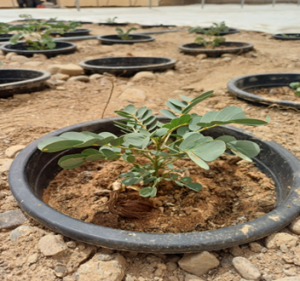
Mushrooms cultivation and native plants research
World population is expected to grow rapidly in the coming years; such expectable increment in human population is predicted to significantly affect the natural resources. Meeting the food demand for the increasing population from the limited land resource is a big challenge. Therefore, it seems very important and urgent to correlate human population growth and food production to avoid food shortage. Accordingly, integrating the mushroom cultivation locally could be one of the ways to satisfy the food demand locally and globally, and therefore preserve the natural resources. Mushrooms are a rich source of nutrients and pharmaceutical products. Mushroom is considered a complete, health food. The nutritional value of mushroom is affected by numerous factors such as species, stage of development and environmental conditions. With regards to mineral composition, mushrooms contain very important mineral such as calcium, phosphorous, sodium, potassium magnesium that present significant impact for human functioning. In addition, mushrooms also are loaded with good amounts of proteins, carbohydrates, fibre, fat, and vitamins that include vitamins B, C, and D. With focus on the medicinal uses, edible fungi have revealed their great health benefits. The quality and the quantity of the metabolites with medicinal uses found in edible mushrooms vary from species to species. Those metabolites include These bioactive compounds include polysaccharides, tri-terpenoids, low molecular weight proteins, glycoprotins and immunomodulating compounds. Accordingly, mushrooms have been shown to promote immune function; boost health; lower the risk of cancer; inhibit tumor growth; help balancing blood sugar; ward off viruses, bacteria, and fungi; reduce inflammation; and support the body's detoxification mechanisms. Furthermore, mushrooms are environmentally eco-friendly as they play many functions for the ecosystem. For the instance, fungi are involved in the nutrients recycle, and they help many plant species in the nutrient uptake. Therefore, the cultivation of fungi and especially edible mushrooms could be one of the main keys to cope with food demand. The delicateness behind the cultivation of mushrooms is the selectivity of the substrate, and the environmental factors requirements. Many species of mushrooms are cultivated worldwide, and the most cultivated and available species is the white mushroom, which is Agaricus bisporus. Although the white mushroom is largely available, the cultivation needs proper substrate and environmental conditions compared to the other with respect to Oyster mushroom which has higher ability to grow from any type of substrate. Generally, implementing mushroom cultivation farm at higher scale needs significant funds to meet the mushroom requirements. On the other hand, in the arid and semi-arid regions, additional costs should be added in the implementation of the mushrooms projects, that will be used to build and to maintain the humidity system due to the extreme temperatures. Therefore, ideally, targeting local products with higher abundance to prepare the substrate could be one of the ways to minimize the cots allocated to the establishing of the mushrooms project. UAE is one of the pioneers in the cultivation of date palms and dates trading, and the cultivation of this plant species is associated with significant wastes generally. Dates palms leaves are a rich source of mineral that include nitrogen (N), phosphorous (P), potassium (K), calcium (Ca), magnesium (Mg), and iron (Fe). Furthermore, dates palm leaves are loaded with important cellulose and lignin. Therefore, these parts can be used as a substrate to grow nutritious product with low cost such as oyster mushroom and other species of mushrooms. In the present work, we are experimenting the impacts of the substrate made from the available local products on the growth of different species of mushroom. The experimentation is done in two main phases that include the making of the biochar using the date palms leaves, and Prosopis juliflora plant parts, and then the effects of this latter and the other ingredient on the growth of edible mushrooms.
Local plants provide the most suitable food and habitat for the native wildlife. In addition, native plants are a good source of pharmaceutical compounds that could be used to treat many disorders. Plants of the regions with water limitations have importantly adjusted their physiology to cope with extreme environmental conditions. Unfortunately, only few information are available regarding those plants. Therefore, we are currently working on the local plant species with the main goal to understand how they evolved according to the changing occurring in their natural habitats. In addition, we currently study the local plants with the main objective to elucidate their nutritional and pharmaceutical components that could be beneficial in food production and medicines. Our recent study was focused on the water drought effects on the growth of one of the important native plants of UAE Senna italica. To understand this, we grown Senna italica plants under three levels of water stress such 6, 12, and 18% of soil moisture in the greenhouse and field conditions for 75 days during the summer in Fujairah. Our findings revealed that Senna italica plants can tolerate up to 18% of soil moisture when growing in the field conditions, while those growing in the greenhouse could tolerate up to 6% of soil moisture. The obtained results could be beneficial to improving agricultural system in the regions with water limitations. The results obtained in the nutritional and pharmaceutical analysis of the native plant shown that indigenous plant species are a rich source of diverse nutrients and pharmaceutical components that can boost the food production. Interestingly, we observed that local plants of UAE present significant nutritional and pharmaceutical components than the plants growing in the countries where water rarefication is the main ecological issue.
